
Philip Henry Gosse FRS, known to his friends as Henry, was an English naturalist and populariser of natural science, virtually the inventor of the seawater aquarium, and a painstaking innovator in the study of marine biology. Gosse created and stocked the first public aquarium at the London Zoo in 1853, and coined the term "aquarium" when he published the first manual, The Aquarium: An Unveiling of the Wonders of the Deep Sea, in 1854. His work was the catalyst for an aquarium craze in early Victorian England.

Stefan Kisielewski, nicknames Kisiel, Julia Hołyńska, Teodor Klon, Tomasz Staliński, was a Polish writer, publicist, composer and politician, and one of the members of Znak, one of the founders of the Unia Polityki Realnej, the Polish libertarian and conservative political party.

Leptodactylus latrans is a species of frog in the family Leptodactylidae. It is native to much of South America east of the Andes, and Trinidad and Tobago. It has many common names, including rana criolla, sapo-rana llanero, butter frog, and lesser foam frog.
Jenkinsia is a genus of round herring in the family Clupeidae. They are found in the central western Atlantic Ocean, the Gulf of Mexico, and the Caribbean Sea. Four recognized species are placed in this genus.

Aiptasia is a genus of a symbiotic cnidarian belonging to the class Anthozoa. Aiptasia is a widely distributed genus of temperate and tropical sea anemones of benthic lifestyle typically found living on mangrove roots and hard substrates. These anemones, as well as many other cnidarian species, often contain symbiotic dinoflagellate unicellular algae of the genus Symbiodinium living inside nutritive cells. The symbionts provide food mainly in the form of lipids and sugars produced from photosynthesis to the host while the hosts provides inorganic nutrients and a constant and protective environment to the algae. Species of Aiptasia are relatively weedy anemones able to withstand a relatively wide range of salinities and other water quality conditions. In the case of A. pallida and A. pulchella, their hardiness coupled with their ability to reproduce very quickly and out-compete other species in culture gives these anemones the status of pest from the perspective of coral reef aquarium hobbyists. These very characteristics make them easy to grow in the laboratory and thus they are extensively used as model organisms for scientific study. In this respect, Aiptasia have contributed a significant amount of knowledge regarding cnidarian biology, especially human understanding of cnidarian-algal symbioses, a biological phenomenon crucial to the survival of corals and coral reef ecosystems. The dependence of coral reefs on the health of the symbiosis is dramatically illustrated by the devastating effects experienced by corals due to the loss of algal symbionts in response to environmental stress, a phenomenon known as coral bleaching.
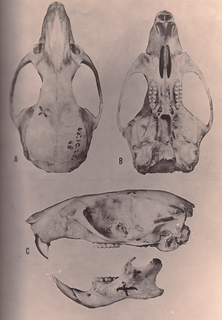
Oryzomys antillarum, also known as the Jamaican rice rat, is an extinct rodent of Jamaica. A member of the genus Oryzomys within the family Cricetidae, it is similar to O. couesi of mainland Central America, from where it may have dispersed to its island during the last glacial period. O. antillarum is common in subfossil cave faunas and is also known from three specimens collected live in the 19th century. Some historical records of Jamaican rats may pertain to it. The species probably became extinct late in the 19th century, perhaps due to the introduction of the small Asian mongoose, competition with introduced rodents such as the brown rat, and habitat destruction.
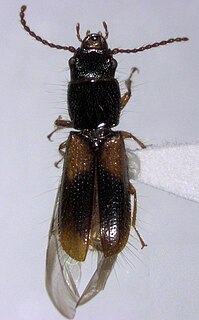
Chaetosomatidae is a small family of beetles, in the suborder Polyphaga.
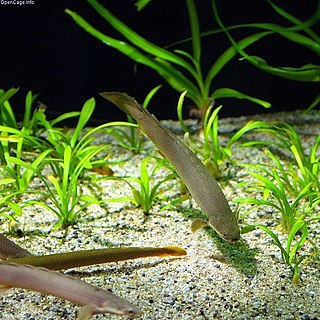
Cladistia is a clade of bony fishes that currently consists of few anguilliform (eel-shaped) remnants of an ancient diversity. Their major synapomorphies are a heterocercal tail in which the dorsal fin has independent rays, and a posteriorly elongated parasphenoid.

Chaetonotidae is a family of gastrotrichs in the order Chaetonotida. It is the largest family of gastrotrichs with almost 400 species, some of which are marine and some freshwater. Current classification is largely based on shape and external structures but these are highly variable. Molecular studies show a high level of support for a clade containing Dasydytidae nested within Chaetonotidae.

Sagartia is a genus of sea anemones in the family Sagartiidae. The genus was first described by Philip Henry Gosse in 1855 and the image is his painting of several species found in British waters included in his book, A history of the British sea-anemones and corals.
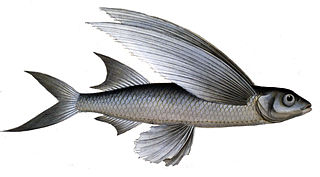
Parexocoetus is a genus of flying fishes. They are found in the tropical and subtropical western Atlantic and Indo-Pacific Oceans. It is the only genus in the subfamily Parexocoetinae which is unique among the flying fishes in having a jaw which is very protrusible and having a joint situated between the cranium and the shoulder girdle which allows the head to be more maneuverable than in other lineages of this family.
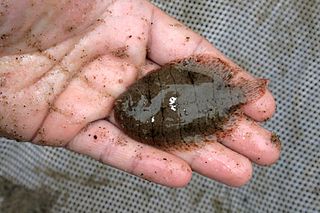
Trinectes is a genus of American soles native to the Americas. Most species are coastal, occurring in both salt and brackish water, but several may enter fresh water and one, T. hubbsbollinger, is restricted to rivers. They are fairly small, with the largest species only reaching 25 cm (9.8 in) in length.
Hypsirhynchus is a genus of snakes of the subfamily Dipsadinae. Species of this genus are found in Jamaica, Hispaniola, and the Bahamas.

Eumops ferox, the fierce bonneted bat or the chestnut mastiff bat, is a species of free-tailed bat found in the Caribbean and Mexico. Until recently, it was synonymous with Wagner's bonneted bat.
Dasydytidae is a family of gastrotrichs in the order Chaetonotida.
Heterolepidoderma is a genus of gastrotrichs belonging to the family Chaetonotidae.
Aspidiophorus is a genus of gastrotrichs belonging to the family Chaetonotidae.
Lepidodermella is a genus of gastrotrichs belonging to the family Chaetonotidae.
Haltidytes is a genus of gastrotrichs belonging to the family Dasydytidae.
Setopus is a genus of gastrotrichs belonging to the family Dasydytidae.











